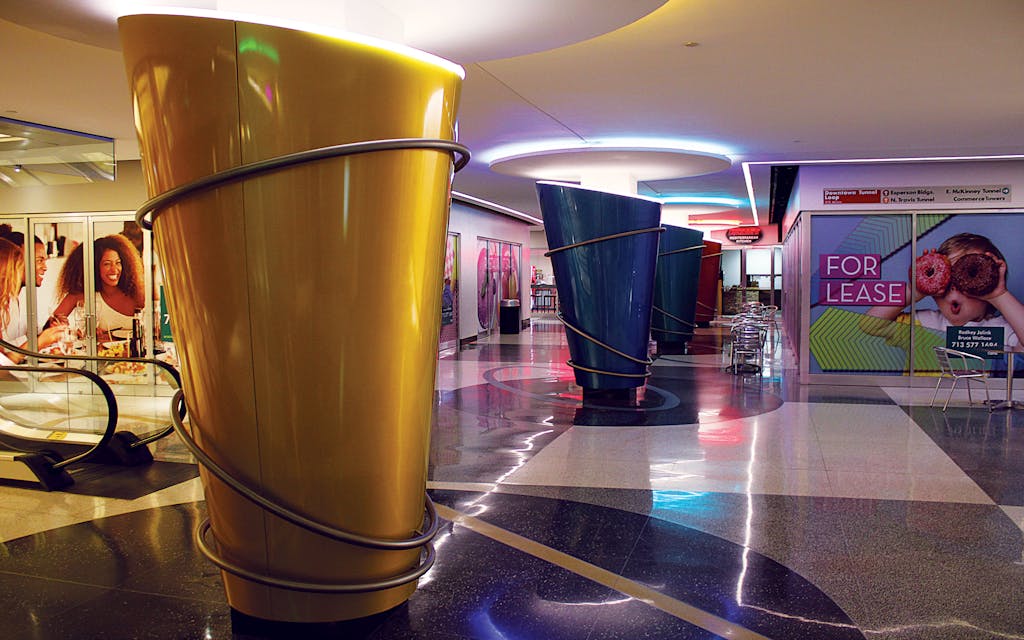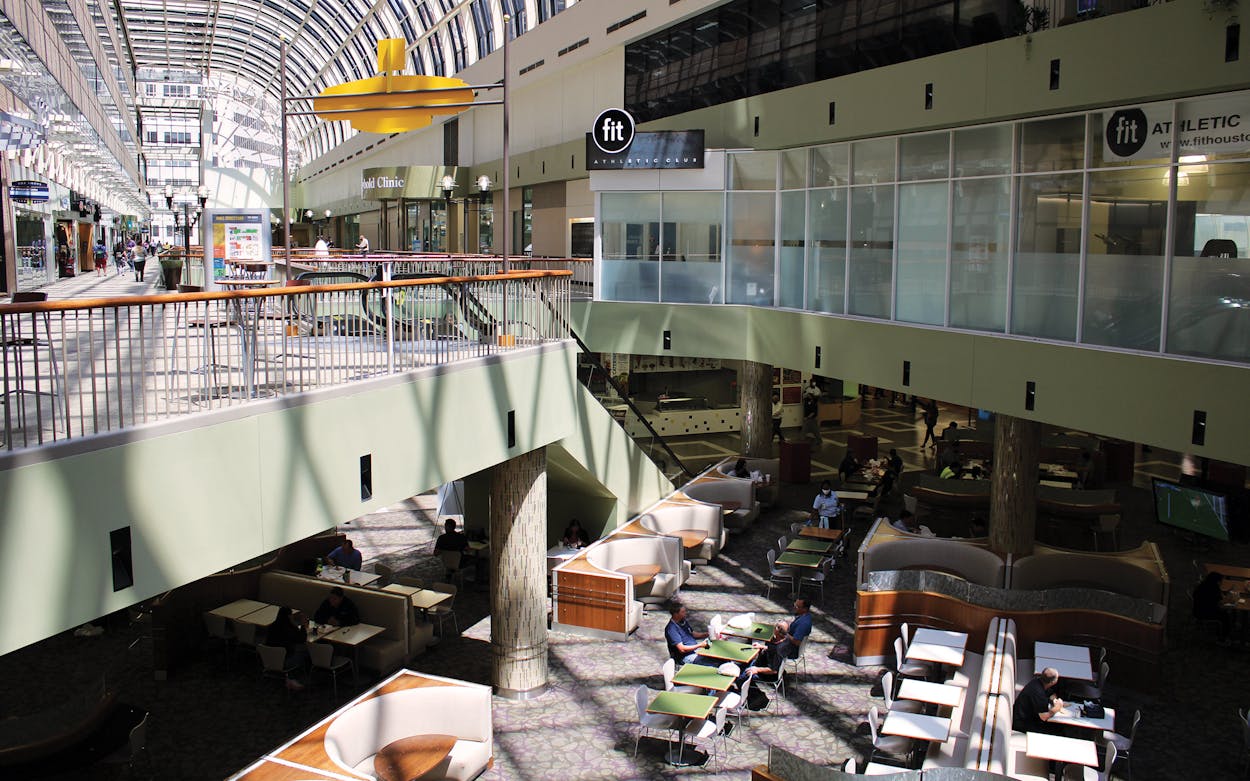For thirty years, Sandra Lord all but lived in Houston’s tunnels. By day, she led tours of the six-and-a-half-mile underground system, a labyrinthine mall that connects City Hall with Discovery Green and the largest downtown office buildings. She bought the first of her two parakeets, Bonnie and Clyde, in a defunct pet store under the old Woolworth building (now a parking garage), ate Vietnamese dumplings almost every day for lunch in the Houston Center on McKinney Street, and got her hair done at Red’s Barber Shop under Fannin. Now in her eighties and in a wheelchair, she entered the tunnel loop last month for the first time in five years. Uncharacteristically, she was speechless.
In the central connection of the entire tunnel system, at 919 Milam, the fluorescent lights were dimmed and almost all the retail spaces were gutted. “For Lease” signs dotted many doors; in other businesses, chairs were stacked on the tables as if we’d wandered in right before closing and not at noon, during what was once peak business hours. “I almost burst into tears,” Lord told me later. “This area used to be booming.”
The story of Houston’s tunnel construction is in many ways the story of Houston itself, driven by rapid expansion and a volatile boom-and-bust cycle. Entertainment magnate Will Horwitz first dug tunnels in 1935 to connect three of his movie theaters under what is now JPMorgan Chase Tower, in part to help patrons avoid the Houston heat. As much a showman as he was a businessman—live hogs occasionally roamed his theaters—Horwitz was inspired by New York’s Rockefeller Center and had the idea to populate the tunnels with businesses.
At first, there were a few shops, a penny arcade, and a German wine tavern. In the fifties, other downtown buildings decided to join the tunnel system and developed their own portions, connected to one another by short hallways, as private malls to attract white-collar workers from above ground. Each section they developed—and styled, with little city guidance—is a time capsule of sorts. Just yards apart are turn-of-the-century shoeshine chairs, neo-futurist fish-tank pillars à la James Bond, and neon lights and linoleum tiles from the golden era of shopping malls in the eighties. Recent additions to the tunnels resemble Silicon Valley–style campuses: a remodeled food court under the Bank of America Tower has clean white walls and long communal work tables, a cross between an Apple store and a school cafeteria.

While there are similar underground networks in Chicago, Dallas, and Oklahoma City, Houston’s is the largest in the U.S. In 2017, the tunnels served 150,000 downtown workers, and nearly all 125 rentable spaces were occupied. But the coronavirus pandemic stemmed the steady flow of foot traffic through the halls. Like birds picking the gunk from between a crocodile’s teeth, the retailers and restaurants have a symbiotic relationship with the big businesses above them. As those corporate employees disappeared when offices went—and then stayed—remote, the ecosystem of the tunnels, which are privately owned, has also been threatened.
Businesses began vacating downtown Houston during last year’s oil bust, and in the first quarter of 2020 the office vacancy rate was around 20 percent. Following stay-at-home orders and months of remote work, that number increased to more than 24 percent, by one measure—the highest in the nation—by the end of last year. Vacancy rates now sit right above pre-pandemic levels, and only around 30 percent of all workers are back in the office full-time, according to Angie Bertinot, director of marketing and communications for the Houston Downtown Management District.
That means business hasn’t been quick to return to the tunnels. Some major downtown employers such as Chevron laid off hundreds of employees in 2020, not all of whom will be rehired, and others such as JPMorgan Chase plan to keep certain positions entirely remote. A majority of downtown businesses expect to transition portions of their workforces to hybrid in-person and remote work, according to a recent survey. Further, major businesses relocating to Houston that in the past might have opted for a building downtown have instead set up shop in the suburbs, such as Hewlett Packard Enterprise, whose new headquarters will be in Spring; Great Lakes Dredge and Dock, which chose the Energy Corridor; and Maddox Defense, which relocated from San Diego to just outside Kempwood.
After getting her bearings in the eerie silence of the tunnels, Lord directed me to Red’s Barber Shop under 1001 Fannin, identifying it as one of the older businesses underground. “I had a hairdresser here once,” she said. “She ended up going to two or three other places, but I kind of followed her around for several years.”
The salon was open, but deathly quiet. Ron Gongora, the owner, said he had shut down completely for six weeks around the time of the state’s stay-at-home order last March. When he opened back up last April, donning masks and concocting homemade disinfectants out of barbicide, water, and bleach because of shortages, the tunnels were a ghost town. Most of the lawyers from the building above him, some of whom had been coming in for lunch-break cuts for three decades, are still remote. “We used to see forty to fifty people walk this hall in a minute,” he told me. “Now it’s four to five people every ten minutes.” Gongora has had to lay off four barbers, and said he’s trying to renegotiate a lease that locks him in for the next eight years. If lease negotiations don’t go his way, he’s considering ditching the tunnels and starting a barbershop in a new location under a different name.


Shop owners throughout the tunnels told me similar stories. The owner of La Dolce Vita Café under the Cullen Center Plaza said he thought of vacating the tunnels after his rent increased just before the pandemic. Matt Rowden at Treebeards, a Southern comfort restaurant under Enterprise Plaza, said his landlord let him skimp on rent the whole year. Almost all vendors underground had to reckon with the fact that the fates of their businesses—whether because of a lack of clients or the cost of rent—were out of their hands.
“We’re trapped in here,” said Lucia Herron of Greenworks Flowers, the only florist in the tunnel, about a ten-minute walk from Red’s. The shop was one of the only vendors under Pennzoil Place to stay open for the majority of the pandemic, even remaining in business after Herron contracted the virus and had to stay home to recover. Since the store opened in 1995, she’s helped decorate lobbies and waiting rooms and conference tables across downtown. But even with vaccination rates increasing, few people seem to be looking for flowers right now.
“They used to call the hours between 11 a.m. and 2 p.m. ‘the holy hours,’” Lord said, because that’s when everybody from the offices would pour out on their lunch breaks. As a worker in the tunnels, “you couldn’t take a break then. You weren’t allowed.” Now, said Delores Rodriguez at Amille’s Coffee, on 1600 Smith, foot traffic dies down completely on Fridays after 12 p.m. Because of low wages, many of her fellow employees are working fewer than thirty hours per week so they can continue to meet unemployment requirements.
This isn’t the first time the businesses in the tunnels have fallen on hard times. During the oil crisis of the early- to mid-eighties, the city’s downtown had a vacancy rate of nearly 50 percent. Then, in the late nineties, Lord said, shop owners flocked to open kiosks near the Enron building; when the company went bankrupt, owners cut their losses and fled to other locations within the tunnels as fast as they could.
Lord also remembers visiting the tunnels a week after Tropical Storm Allison in 2001. Water had flowed in through the Theater District Garage into one side of the tunnels on the edge of Buffalo Bayou, nearly reaching the central loop at 919 Milam. Many businesses had to close for repairs. But despite the severity of the damage in that side of the tunnels, she said, the majority of the system was up and running days later.
As Lord and I walked the halls, sometimes we’d still happen upon floors with old flood lines on the walls up to our knees, some complete with newly installed air locks like those inside a submarine. “In the tunnels it never rains,” Lord told me, “but sometimes it drips.” Adaptations almost always come late. But this time, Lord doubts the tunnels will ever be the same. “I don’t think they’ll ever bounce back the way they did in the nineties and 2000s,” she said. “I don’t think it’ll disappear. It just won’t be essential anymore.”






